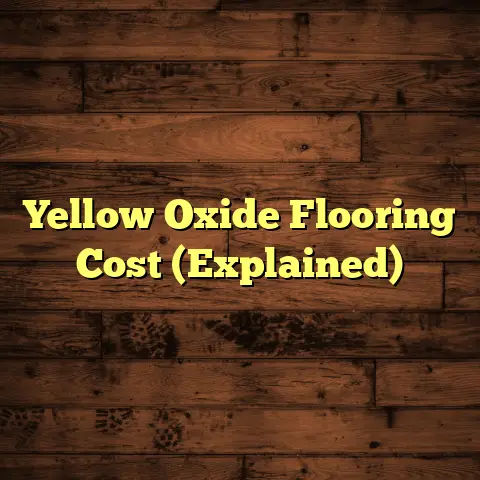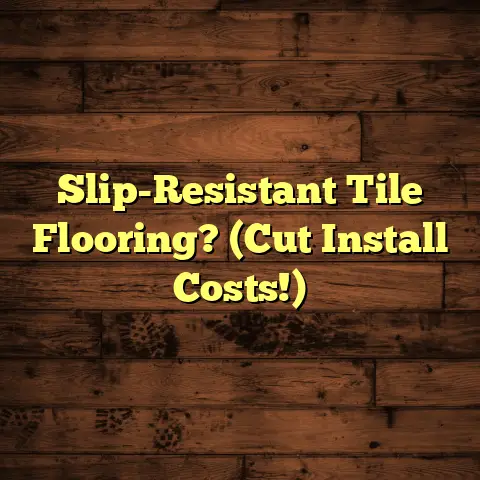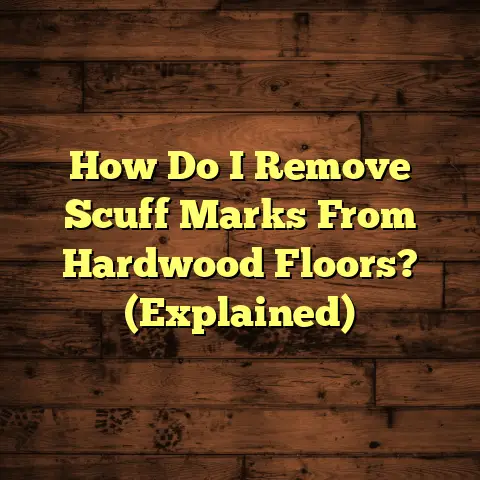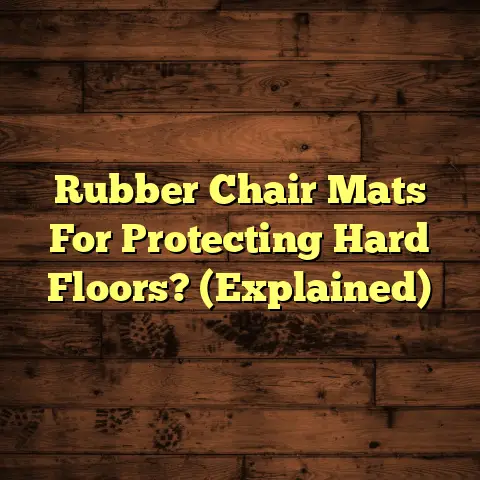How Much Vinegar To Clean Laminate Floors? (Explained)
Cleaning laminate floors can be a breeze, especially when you know the right techniques and ingredients to use.
As a flooring contractor with years of experience, I often get asked about using vinegar for cleaning laminate floors.
Why vinegar, you might wonder?
Not only is it effective, but it also offers health benefits that many commercial cleaners lack.
Let me walk you through everything I’ve learned about using vinegar for laminate floor cleaning, including my personal experiences and insights.
The Power of Vinegar
Vinegar is a natural disinfectant and deodorizer.
It can tackle grime and dirt while being safe for your family and pets.
When I first started using vinegar, I was amazed at how well it cut through the residue that built up on my clients’ floors.
I remember working on a home where the laminate floors were dull and lifeless.
After a good cleaning with vinegar, they sparkled like new.
How Much Vinegar to Use?
So, how much vinegar should you use?
The ideal ratio is one cup of white vinegar for every gallon of warm water.
This solution is strong enough to clean without causing damage to the laminate surface.
If you’re dealing with particularly stubborn stains, you might want to use a bit more vinegar—up to one and a half cups—but be cautious.
Mixing Your Solution
- Gather Your Supplies: You’ll need a bucket, warm water, white vinegar, and a microfiber mop.
- Mix: In your bucket, combine one cup of vinegar with a gallon of warm water.
- Test: Before applying it to the entire floor, test it on a small, inconspicuous area to ensure it doesn’t cause any discoloration.
Cleaning Process
When I clean laminate floors with vinegar, I follow these steps:
- Sweep or Vacuum: Always start by removing dust and debris.
A clean surface will enhance the effectiveness of your cleaning solution. - Mop with Vinegar Solution: Dip your microfiber mop into the vinegar solution and wring it out well.
Excess water can damage laminate flooring. - Mop in Sections: Work in small sections, rinsing the mop frequently in clean water to avoid spreading dirt around.
- Dry the Floor: After mopping, use a dry microfiber cloth or mop to remove any remaining moisture.
This step is crucial as standing water can warp laminate.
Personal Experiences
I recall one project where the homeowners had tried everything to restore their laminate floors but to no avail.
They had used various commercial cleaners that left behind streaks and didn’t really remove the embedded dirt.
After using my vinegar solution, they were thrilled with the results.
The glossy finish was back, and they were amazed at how easy it was to achieve.
However, I’ve also faced challenges.
On one occasion, a client had an older laminate floor that had started to show signs of wear and tear from years of improper cleaning methods.
Even though vinegar worked wonders for cleaning, it couldn’t fix the damage already done.
That experience taught me the importance of using the right cleaning methods from day one.
Challenges with Vinegar
While vinegar is fantastic for cleaning, it’s not without its drawbacks.
For instance, if your floors have any wax coatings or finishes, vinegar can strip those away.
In such cases, it’s better to stick with products specifically designed for laminate flooring.
Alternative Solutions
If vinegar doesn’t quite do the trick or you’re concerned about its effects on your specific flooring type, I’ve experimented with several alternatives:
- Commercial Laminate Cleaners: These often come with specific formulations that are gentle on laminate while effectively removing dirt.
- Dish Soap Mix: A few drops of dish soap mixed in warm water can also be effective for routine cleaning.
Each option has its pros and cons.
Commercial cleaners can be more expensive but may offer specialized formulas for tough stains.
Tips for Maintaining Laminate Floors
In my experience, prevention is key to maintaining the beauty of laminate flooring:
- Regular Sweeping: Keep dirt and grit off your floors to prevent scratches.
- Avoid Excess Water: Always use a damp mop rather than soaking wet—standing water is a laminate floor’s enemy.
- Use Mats: Placing mats at entry points can catch dirt before it reaches your floors.
- Immediate Spill Cleanup: Address spills right away to avoid staining or warping.
- Furniture Pads: Use pads under furniture legs to prevent scratches when moving items around.
- Avoid Harsh Chemicals: Stay away from bleach or ammonia-based cleaners as they can damage the finish of your laminate floors.
Understanding Different Cleaning Methods
While vinegar is one effective method for cleaning laminate floors, there are several other approaches worth discussing.
Each method has its strengths and weaknesses based on factors like cost, effectiveness, and ease of use.
Steam Cleaning
Steam cleaning is another popular method for cleaning laminate floors.
It uses high-temperature steam to sanitize and lift dirt without chemicals.
However, steam cleaning comes with risks; excessive moisture can warp or damage your laminate flooring over time.
Pros of Steam Cleaning
- Sanitizes surfaces effectively
- No need for chemical cleaners
Cons of Steam Cleaning
- Risk of moisture damage
- More expensive equipment required
Commercial Cleaners
As mentioned earlier, there are many commercial cleaners specifically formulated for laminate floors.
These products can effectively clean without causing damage but can be pricier than DIY solutions like vinegar.
Pros of Commercial Cleaners
- Targeted formulas for specific stains
- Convenient and easy to use
Cons of Commercial Cleaners
- Often contain chemicals that may be harmful
- Can be more expensive over time
DIY Solutions Beyond Vinegar
In addition to vinegar and dish soap, there are other DIY solutions worth exploring:
- Baking Soda Paste: Mixing baking soda with water creates a paste that can help lift stubborn stains.
- Club Soda: For quick spill cleanup, club soda can be an effective option due to its carbonation.
- Olive Oil and Vinegar Mix: A combination of olive oil and vinegar not only cleans but also adds shine.
Each of these methods has its own application and success rate based on the situation.
Cost Estimation with FloorTally
When managing flooring projects, accurate cost estimation is essential.
That’s where FloorTally comes into play for me.
With its user-friendly interface, I can input all necessary details about materials, labor rates, and even waste factors.
For instance, during a recent renovation project in my area, I used FloorTally to generate estimates for a client wanting to install laminate flooring in their living room and hallway.
The estimates came back detailed and accurate, enabling me to provide them with realistic budgets.
This tool has saved me hours of work and allowed me to focus on what I enjoy most—installing beautiful floors.
Common Problems Encountered While Cleaning Laminate Floors
Over the years, I’ve encountered various challenges while cleaning laminate floors—some predictable and others surprising.
Here are some common issues and how I’ve dealt with them:
Streaking After Cleaning
One common complaint from clients is streaking after cleaning their laminate floors.
This often happens when too much cleaning solution is used or when the mop isn’t rinsed out frequently enough.
Solution
To avoid streaking:
- Use less solution and make sure to wring out your mop thoroughly.
- Rinse your mop in clean water frequently while working through sections.
Residue Buildup
Sometimes after repeated use of certain cleaners (even vinegar), you can notice residue buildup on the surface of the laminate flooring.
Solution
If you encounter residue:
- Try rinsing the floor with plain water after using any cleaner.
- Alternatively, switch to a different cleaning method temporarily until the buildup is resolved.
Scratches on Laminate Floors
Scratches can occur from furniture movement or from grit that gets trapped underfoot.
Solution
To minimize scratches:
- Use furniture pads under heavy items.
- Regularly sweep or vacuum to keep grit at bay.
- For existing scratches, consider using a laminate repair kit that matches your floor’s finish.
Seasonal Maintenance Tips
Changing seasons bring different challenges for maintaining laminate flooring.
Here’s how I adapt my cleaning routine throughout the year:
Spring Cleaning
As flowers bloom and dust settles from winter hibernation, spring cleaning becomes essential:
- Deep clean with your vinegar solution.
- Inspect for any damages caused by winter conditions.
- Address any issues like scratches or wear before summer activities kick in.
Summer Maintenance
Summer often means increased foot traffic as families spend more time indoors:
- Keep mats at entry points to catch dirt.
- Be mindful of humidity levels that might affect your floors; excessive humidity can lead to warping.
Fall Preparations
With leaves falling and winter approaching, it’s time to prepare:
- Deep clean before holiday gatherings.
- Inspect your home’s heating systems; sudden temperature changes can affect laminate integrity.
Winter Precautions
Winter brings snow and slush that can wreak havoc on floors:
- Use absorbent mats at entrances.
- Clean up spills immediately to prevent moisture damage from snowmelt.
Final Thoughts on Using Vinegar
Using vinegar to clean laminate floors is an effective and health-conscious choice that I wholeheartedly recommend based on my personal experiences.
While it may not suit every situation—especially if your floors have existing damage or specialized finishes—it’s a great starting point for most cleaning tasks.
By mixing one cup of vinegar with a gallon of warm water, you can tackle grime effectively while also being mindful of your family’s health.
Remember to always test on a small area first and adjust your methods according to your specific flooring conditions.
With regular maintenance and careful cleaning practices, your laminate floors can remain beautiful for years to come.
So grab that vinegar and get cleaning!
Overall, using vinegar is just one piece of the puzzle when it comes to maintaining laminate flooring.
Combining different cleaning methods, staying proactive about care routines, and utilizing tools like FloorTally for cost estimation can help ensure long-lasting beauty in your home’s flooring.
Whether you choose vinegar or explore other options, what matters most is finding what works best for you while keeping your space clean and inviting!





